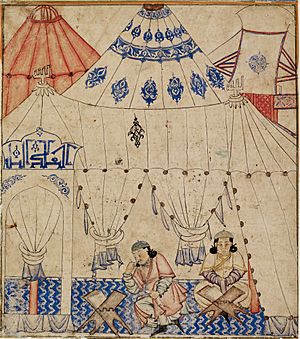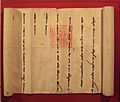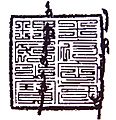Ilkhanate facts for kids
Quick facts for kids
Ilkhanate
ایل خانان
|
|||||||||||||||||||||||||||||||||||||||||||
|---|---|---|---|---|---|---|---|---|---|---|---|---|---|---|---|---|---|---|---|---|---|---|---|---|---|---|---|---|---|---|---|---|---|---|---|---|---|---|---|---|---|---|---|
| 1256–1335 | |||||||||||||||||||||||||||||||||||||||||||
|
Flag depicted in the Angelino Dulcert's map of 1339 and the Catalan Atlas of 1375
|
|||||||||||||||||||||||||||||||||||||||||||
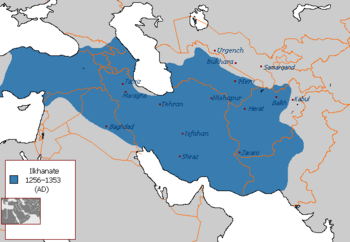
The Ilkhanate at its greatest extent
|
|||||||||||||||||||||||||||||||||||||||||||
| Status |
|
||||||||||||||||||||||||||||||||||||||||||
| Capital |
|
||||||||||||||||||||||||||||||||||||||||||
| Common languages |
|
||||||||||||||||||||||||||||||||||||||||||
| Religion |
|
||||||||||||||||||||||||||||||||||||||||||
| Government | Monarchy | ||||||||||||||||||||||||||||||||||||||||||
| Khan | |||||||||||||||||||||||||||||||||||||||||||
|
• 1256–1265
|
Hulagu Khan | ||||||||||||||||||||||||||||||||||||||||||
|
• 1316–1335
|
Abu Sa'id | ||||||||||||||||||||||||||||||||||||||||||
| Legislature | Kurultai | ||||||||||||||||||||||||||||||||||||||||||
| History | |||||||||||||||||||||||||||||||||||||||||||
|
• Established
|
1256 | ||||||||||||||||||||||||||||||||||||||||||
|
• Disestablished
|
1335 | ||||||||||||||||||||||||||||||||||||||||||
| Area | |||||||||||||||||||||||||||||||||||||||||||
| 1310 est. | 3,750,000 km2 (1,450,000 sq mi) | ||||||||||||||||||||||||||||||||||||||||||
|
|||||||||||||||||||||||||||||||||||||||||||
The Ilkhanate (also called Il-khanate) was a powerful kingdom. It was part of the huge Mongol Empire. This kingdom was ruled by the Mongol House of Hulagu.
Hulagu Khan, a grandson of Genghis Khan, took control of the Middle Eastern part of the Mongol Empire in 1260. The main lands of the Ilkhanate were in what is now Iran, Azerbaijan, and Turkey. At its biggest, it also included parts of Iraq, Syria, Armenia, Georgia, Afghanistan, Turkmenistan, Pakistan, and parts of Dagestan and Tajikistan.
Later Ilkhanate rulers, starting with Ghazan in 1295, became Muslims. In the 1330s, a terrible sickness called the Black Death hit the Ilkhanate. Its last khan, Abu Sa'id, died in 1335. After his death, the kingdom broke apart. Even though the Ilkhanid rulers were not from Iran, they tried to connect themselves to Iran's ancient history. They hired historians to show that the Mongols were the rightful heirs to the Sasanian Empire.
Contents
How the Ilkhanate Began
When Muhammad II of Khwarazm killed some Mongol merchants, Genghis Khan started a war in 1219. The Mongols quickly took over his empire between 1219 and 1221. Iran was badly damaged by the Mongol army.
Muhammad's son, Jalal ad-Din Mingburnu, came back to Iran around 1224. He gathered support from local states. He even stopped the first Mongol attack on Central Persia. However, a Mongol army led by Chormaqan defeated him in 1231. During this time, Azerbaijan and southern Persian areas like Fars and Kerman joined the Mongols. They agreed to pay tribute.
The Mongols also invaded Armenia and Georgia around 1234. By 1237, most of Persia, Armenia, Georgia, Afghanistan, and Kashmir were under Mongol control. After a big battle in 1243, the Mongols also took over Anatolia. The Seljuk Sultanate of Rûm and the Empire of Trebizond became their subjects.
In 1236, Ögedei Khan ordered the rebuilding of Greater Khorasan and the city of Herat. Mongol military leaders often camped in the Mughan plain in Azerbaijan. Rulers of Mosul and Cilician Armenia also submitted to the Great Khan. In 1251, Möngke Khan ordered a new census. He said that everyone in the Mongol-ruled Middle East should pay taxes based on what they owned.
Hulagu Khan: The First Ilkhan
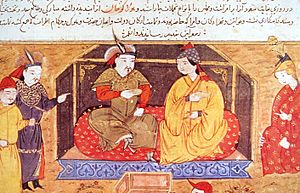
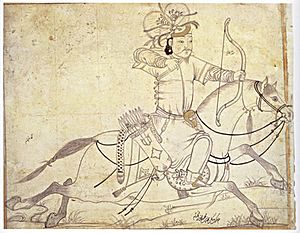
Hulagu Khan was the third son of Tolui and a grandson of Genghis Khan. He was also the brother of Möngke Khan and Kublai Khan. Hulagu became the first khan of the Ilkhanate. In 1251, his brother Möngke became the Great Khan. Hulagu was then given the job of conquering the Abbasid Caliphate.
He took a large part of the Mongol army for this mission. Many Chinese scholars and astronomers joined him. A famous Persian astronomer, Nasir al-Din al-Tusi, learned from them. An observatory was built in Maragheh. Hulagu took over from Baiju in 1255. He established Mongol rule from Transoxiana to Syria.
Hulagu destroyed the Nizari Ismaili state in 1256. He then ended the Abbasid Caliphate in 1258. In 1258, Hulagu declared himself Ilkhan, meaning a "subordinate khan." He then moved into Gaza, briefly conquering Ayyubid Syria and Aleppo in 1260.
Möngke's death made Hulagu return to Mongolia for a new Great Khan election. He left a small army in Palestine. This army was defeated by the Mamluks from Egypt at the battle of Ain Jalut.
A war started between Hulagu and Berke of the Golden Horde in 1262. This was because three princes from Berke's family died while serving Hulagu. Berke also believed Hulagu was not sharing war treasures fairly. Berke joined forces with the Mamluks against Hulagu. The Golden Horde sent Nogai Khan to attack the Ilkhanate. Hulagu pushed him back in 1262. But later, Nogai's forces surprised and defeated the Ilkhanid army. Many soldiers drowned when ice broke on the frozen Terek River.
In 1262, Hulagu gave Greater Khorasan and Mazandaran to his son Abaqa. He gave northern Azerbaijan to his son Yoshmut. Hulagu himself lived as a nomad in southern Azerbaijan and Armenia. Early in his rule, the Ilkhanate faced many revolts. Things began to calm down after Shams al-Din Juvayni became vizier (a high official) in 1262. Hulagu died in February 1265. His son Abaqa took his place.
The Middle Years (1265–1291)
When Abaqa became khan, he immediately faced an invasion from Berke of the Golden Horde. This invasion ended when Berke died. In 1270, Abaqa defeated an attack by Ghiyas-ud-din Baraq. Abaqa's brother, Tekuder, then attacked Bukhara.
In 1277, the Mamluks invaded Anatolia. They defeated the Mongols at the Battle of Elbistan. Abaqa was upset by this defeat. He executed the local ruler and replaced him with a Mongol prince. In 1281, Abaqa sent another army against the Mamluks. But they were also defeated at Homs.
Abaqa died in 1282. This led to a fight for who would rule next. His son Arghun and his brother Tekuder both wanted to be khan. Tekuder was chosen by the Mongol nobles. Tekuder was the first Muslim ruler of the Ilkhanate. But he did not try to force people to convert. He tried to change Mongol traditions to Islamic ones. This made him lose support from the army. Arghun used this to gain support from non-Muslims. Tekuder was overthrown by Arghun's foster son, Buaq. Arghun became Ilkhan in 1286.
During Arghun's rule, he tried to reduce Muslim influence. He fought against the Mamluks and a Muslim Mongol leader named Nawruz. To pay for his wars, Arghun let his viziers control spending. But this was very unpopular. His former supporters turned against him. Both viziers were killed. Arghun was murdered in 1291.
Changing Religions (1291–1316)
The Ilkhanate began to weaken under Arghun's brother, Gaykhatu. Most Mongols became Muslim, but the royal court stayed Buddhist. Gaykhatu spent a lot of money to keep his followers happy. This ruined the kingdom's finances. His vizier tried to fix this by using paper money, like in China. But this plan failed badly. Gaykhatu was overthrown in 1295. His cousin Baydu took his place. Baydu ruled for less than a year. He was overthrown by Gaykhatu's son, Ghazan.
Hulagu's family ruled Persia for 80 more years. They allowed different religions, like Shamanism, Buddhism, and Christianity. But in 1295, Islam became the official state religion. Even after converting, the Ilkhans still fought the Mamluks. The Mamluks had defeated both Mongol invaders and Crusaders.
The Ilkhans tried to invade Syria many times. But they could never hold onto the land against the Mamluks. They eventually gave up their plans to conquer Syria. This was partly because of civil wars within the Mongol Empire. Also, other Mongol kingdoms to the north and east were hostile. The Chagatai Khanate and the Golden Horde threatened the Ilkhanate. This stopped them from expanding westward. However, the Yuan dynasty in China was an ally of the Ilkhanate.
Ghazan became Muslim because of Nawruz. He made Islam the official religion. Christian and Jewish people lost their equal status. They had to pay a special tax called jizya. Ghazan told Buddhists to convert or leave. He also ordered their temples to be destroyed. But he later became less strict. After Nawruz was removed and killed in 1297, Ghazan made it illegal to be religiously intolerant. He tried to improve relations with non-Muslims.
The Ilkhanate's change to Islam did not stop its conflicts with other Muslim states. The fight with the Mamluks over Syria continued. The Battle of Wadi al-Khazandar was a major Mongol victory over the Mamluks. It gave them control of Syria for a few months. Ghazan's policies mostly continued under his brother Öljeitü. Öljeitü had been baptized as a Christian baby. He had also been interested in Buddhism. He became a Sunni Muslim, but still kept some old shamanic beliefs. In 1309-10, he became a Shi'ite Muslim.
The conversion of Mongols to Islam was not always deep at first. The process of establishing Islam took time. Öljeitü's historian recorded that a leader named Qutlugh-Shah suggested abandoning Islam. He wanted Mongols to go back to the ways of Genghis Khan. The historian also said that Öljeitü himself briefly went back to old ways. As Muslims, Mongols often favored Sufism.
The Ilkhanate Breaks Apart (1316–1357)
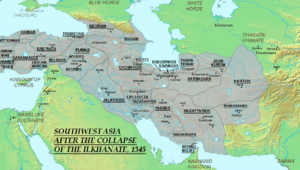
Öljaitü's son, Abu Sa'id Bahadur Khan, was the last Ilkhan. He became ruler in 1316. He faced rebellions in Khorasan and an invasion by the Golden Horde. An Anatolian leader also rebelled. This rebellion was crushed in 1319.
Under the influence of a leader named Chupan, the Ilkhanate made peace with other Mongol groups and the Mamluks. In 1327, Abu-Sai'd replaced Chupan with "Big" Hasan. Hasan was accused of trying to kill the khan. He was sent away to Anatolia in 1332. Non-Mongol leaders were given too much military power. This upset the Mongol leaders.
In the 1330s, outbreaks of the Black Death (a deadly plague) swept through the Ilkhanate. Both Abu-Sai'd and his sons died from the plague by 1335. After this, different leaders tried to put their own candidates on the throne. This led to many short-lived khans. In 1357, Jani Beg of the Golden Horde conquered Tabriz for a year. This officially ended the Ilkhanate.
Government and Daily Life
Unlike the Yuan dynasty in China, the Ilkhanate allowed local people to hold high positions. They ruled with a mix of Central Asian-Persian officials and Turco-Mongol military officers. Not all Persian officials were Muslim. For example, a vizier from 1288 to 1291 was Jewish. A famous vizier and historian, Rashid-al-Din Hamadani, was a Jewish convert to Islam.
The Ilkhanate Mongols remained nomadic, meaning they moved from place to place. Their routes covered central Iraq, northwest Iran, Azerbaijan, and Armenia. They directly ruled Iraq, the Caucasus, and western and southern Iran. Anatolia was the richest province. It provided a quarter of the Ilkhanate's income. Iraq and Diyarbakir together provided about 35 percent.
In 1330, Abkhazia was reunited with the Kingdom of Georgia. However, the tribute (payments) from Georgia to the Il-Khans dropped a lot between 1336 and 1350. This was due to wars and famines.
Legacy of the Ilkhanate
The Ilkhanate had a big impact on the Middle East. The Mongol Empire made trade and business across Asia much easier. Communication between the Ilkhanate and the Yuan dynasty in China helped this growth. The Ilkhanids even used Chinese dragon clothing and the Chinese Emperor title. They also created seals with Chinese characters.
The Ilkhanate also helped prepare the way for the later Safavid kingdom and modern Iran. Hulagu's conquests brought Chinese influence to Iran. This, along with support from his successors, helped Iran develop its unique architecture. Under the Ilkhans, Iranian historians also started writing in their native Persian language instead of Arabic.
Early forms of double-entry accounting were used in the Ilkhanate. This system was later adopted by the Ottoman Empire. These accounting methods developed on their own, separate from Europe. They were mainly used because of economic changes from Ghazan Khan's reforms in 1295-1304.
Ilkhans: The Rulers
House of Hulagu (1256–1335)
- Hulagu Khan (1256–1265)
- Abaqa Khan (1265–1282)
- Ahmad Tegüder (1282–1284)
- Arghun (1284–1291)
- Gaykhatu (1291–1295)
- Baydu (1295)
- Mahmud Ghazan (1295–1304)
- Muhammad Khodabandeh (Oljeitu or Öljaitü) (1304–1316)
- Abu Sa'id Bahadur (1316–1335)
After the Ilkhanate broke apart, different regional states put forward their own rulers.
Later Claimants (1335–1357)
- Arpa Ke'ün (1335–1336) (from the House of Ariq Böke)
- Musa (1336–1337) (puppet of 'Ali Padshah)
- Muhammad (1336–1338) (Jalayirid puppet)
- Sati Beg (1338–1339) (Chobanid puppet)
- Sulayman (1339–1343) (Chobanid puppet)
- Jahan Temür (1339–1340) (Jalayirid puppet)
- Anushirwan (1343–1356) (Chobanid puppet)
- Ghazan II (1356–1357) (known only from coins)
- Togha Temür (c. 1338–1353) (from eastern Persia)
- Luqman (1353–1388) (son of Togha Temür)
Images for kids
See also
 In Spanish: Ilkanato para niños
In Spanish: Ilkanato para niños



